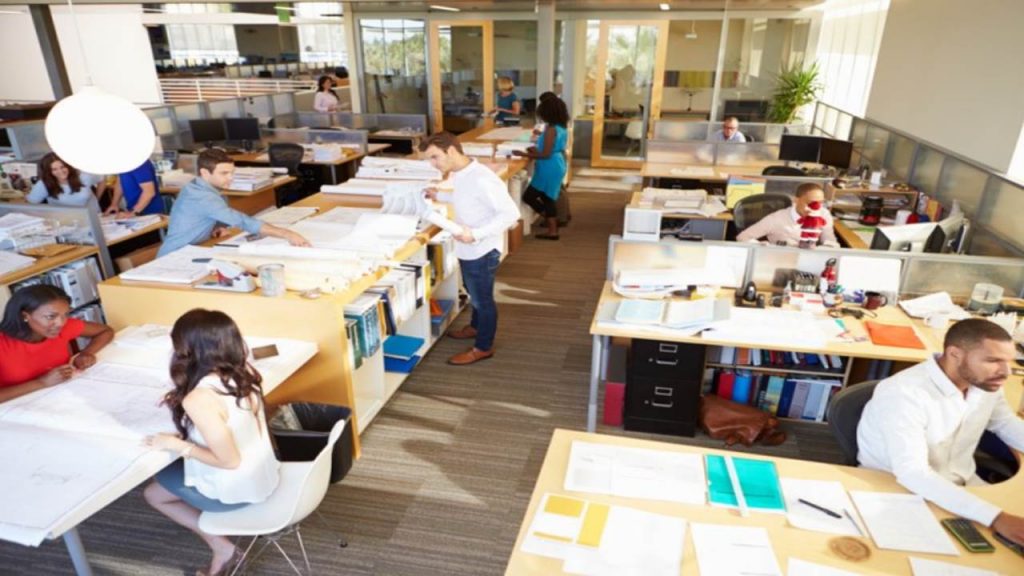Anyone who works in the business sector is much aware of the open office design. But what is it? In this design, instead of having the employees seated in cubicles with walls separating them, the workers sit amongst each other. People adopted the concept to promote communal and open spaces. Though such offices have become more developed than ever before, the rifts in the design are already visible. The open workplace concept advocates camaraderie and collaboration.

However, post its adoption, employees have had complaints of a lack of privacy, recurrent distractions, and a needless feeling of over-exposure while at work. So, here, we’ll discuss with you some of the pros and cons of the open office plans. Let’s get started and find out if such a floor layout is suitable for your startup or not.
Pros
Anahita, who offers do my programming homework services online, says that the open offices were commenced to overcome the shortcomings of the cubicle-reliant or the private-office designs. On isolating the employees from one another, it smothered their ability to work in unison. As a result of it, individualistic and an unhealthy office environment prevailed. Despite it all, people do believe that there are a couple of pros of open office designs. So, let’s get to know more about them.
Camaraderie
When the employees work in a shared space, they get a feeling of togetherness. So, instead of independently pursuing the tasks, they work together and finish the job-in-hand.
Managers are more accessible
By eliminating the cubicle structure, it gets easier for the employees to walk up to their bosses. Naturally, when the supervisors and the managers aren’t segregated via closed doors, reaching out to them is more natural.
Team supervision is easy
Since the managers are more accessible to the team, the administration gets easier and more efficient.
Collaboration
Kylie, who offers do my accounting homework services, says that when there are fewer barriers in an office space amongst the team members, it promotes a more collaborative atmosphere. On the other hand, when the employees are isolated in a work space, they stop seeing themselves as part of a team. It restricts them from seeking advice or input from a co-worker.
Cost-Effectiveness
Setting up an open work space is way cheaper than designing cubicles and private work spaces.
Adaptable to change
When a work space has an open floor plan, making amendments to cater to newer talent is easier.
Aesthetically Appealing
Open work spaces look more modern and appealing. They make the organization look forward and fresh.
Communication
The presence of physical barriers amongst the team members leads to barriers in ideas too. Austin, who recently had to pay someone to write my research paper, says that since he had a cubicle design structure in his workspace, he always hesitated in communicating with his co-workers. It did not just seem inconvenient but also required a lot of effort.
Comfortable
Since there is a better flow of air and light, it puts people at ease, making them more comfortable.
It’s Hip
Lastly, the open office concept is a trending thing. A lot of new agencies are following this trend and are reaping great benefits.
Cons
Today, the open office concept is burgeoning. However, a lot of employers do find the concept inconvenient. Some of the features and supposed pros, even backfired adding to the grievances of the employees. So, here, let us take a look at a few such complaints and hassles faced by the workers.
Distraction
Kiara, who offers the best block chain courses, says that though the offices make the employees more accessible and promote communication and collaboration, it can be distracting when you wish to focus on a task.
No Privacy
In an open office environment, the employees feel more exposed to each other. A lot of times, it kills their privacy.
The feeling of Over-Supervision or Micro-Management
Open offices indeed make the officers, managers, and the team more accessible. However, employees complain that in such an environment, they feel constantly monitored. It puts them under stress, and there’s constant pressure to look busy, and that hampers productivity.
More Conflicts
Over-exposure to each other can often lead to conflicts. Moreover, the pressure of constant exposure often adds to irritability resulting in disagreements and arguments.
Spread of Germs
Pia, who did an excellent semrush review online, says that with more contact, there is increased exposure to dirt and germs, transporting from one another. It can lead to sicker employees which can hamper productivity.
Job Dissatisfaction
As a result of these minor stress and trouble, there can be a sense of unhappiness amongst the employees. It makes it impossible for employers to avoid employee turnover.
Bottom Line – The Harvard Study
Following the recent study of open spaces by Harvard University, it was found that its claims failed miserably. Instead of promoting collaboration and easy communication, the open floor plan leads to a social withdrawal amongst the employees. As a result of it, they avoided direct communication and interacted more freely over an IM or email.
Conclusively, the claims of camaraderie, communication, and fluent collaboration failed. Laila, who offers pay for research paper services, states that in reality, morale and collaboration are less in an open workspace. So, should you opt for such an office environment for your startup? Most likely not! It is okay for teams to work together for a project in an open space, but on a day-to-day basis, startups should stick to the private cubicle work arena.

